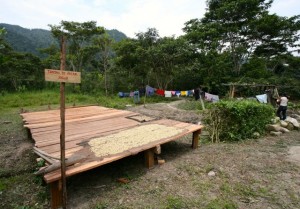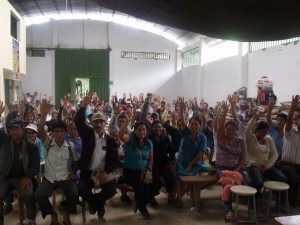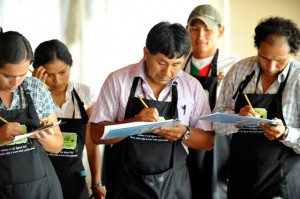The frosts and droughts of Brazil’s coffee harvest season may sometimes dominate the coffee conversation, but Peru, Brazil’s neighbor, should not be overlooked. Peru is one of the leading coffee-producing countries in the world, with half of the country’s 24 districts producing coffee. Moreover, Peru is a powerhouse of certified coffees, and the largest exporter of fair-trade coffee in the world.
 Part of what makes Peru’s coffee unique are the farmers that grow it. Coffee production in Peru covers 380,000 hectares (939,000 acres), the majority of which are cultivated by smallholders; coffee farms in Peru are, on average, 2.37 hectares. Seventy-five percent of this land lies high in Peru’s green mountains at 1,300 meters or higher, meaning that the Typica, Caturra, Bourbon, and other varieties grown in Peru travel down steep slopes on donkeys, bicycles, carts, and farmers’ backs to make it to dry mills and eventually to port.
Part of what makes Peru’s coffee unique are the farmers that grow it. Coffee production in Peru covers 380,000 hectares (939,000 acres), the majority of which are cultivated by smallholders; coffee farms in Peru are, on average, 2.37 hectares. Seventy-five percent of this land lies high in Peru’s green mountains at 1,300 meters or higher, meaning that the Typica, Caturra, Bourbon, and other varieties grown in Peru travel down steep slopes on donkeys, bicycles, carts, and farmers’ backs to make it to dry mills and eventually to port.
Peru’s 2014 Harvest
Peru did not escape last year’s Roya outbreak, which led to a loss of 40% of the crop in hard-hit regions such as San Ignacio. Oscar Gonzales, Sustainable Harvest’s Supply Director in Peru, reports that the 2014 harvest is showing recuperation from these losses, with only 25% being affected by Roya. The best 2014 coffees in terms of yield, productivity, and quality are coming out of Cajamarca and Amazonas, but Selva Central and San Ignacio are also recovering with infrastructure improvements and renovation.
The 2014 Peru harvest is in full swing, with lots being processed, consolidated, and shipped right now. Here is a quick update from just a few of our supplier partners in Peru:
 Selva Andina in Jaén has wowed our cuppers this season with its extremely clean and complex coffee with a very smooth body, cherry notes, and a nutella-like sweetness. It’s standout profile is partially due to its brand new cupping lab, which has helped the cooperative take quality analysis to the next level. Selva Andina also started exporting its own coffee, giving it further control of its product as it heads to port.
Selva Andina in Jaén has wowed our cuppers this season with its extremely clean and complex coffee with a very smooth body, cherry notes, and a nutella-like sweetness. It’s standout profile is partially due to its brand new cupping lab, which has helped the cooperative take quality analysis to the next level. Selva Andina also started exporting its own coffee, giving it further control of its product as it heads to port.
In recent years, the Aprovat Cooperative has invested in its own processing plant, warehouse, and cupping lab, which have brought out the quality in its creamy, citrusy cup profile. The co-op’s infrastructure improvements and strong leadership under general manager Helgar Zelada have lead them to implement a successful micro-lot program, which brought coffees from distinct micro-climates to roasters this year.
In 2008, the Chirinos cooperative brought a specialist from Colombia to teach its members how to produce organic fertilizer cheaply and on a large scale, subsidizing the fertilizer for its farmers and creating tangible gains in productivity and quality of its members’ coffee. Now, this style of fertilizer plant is being adopted by coffee co-ops across the country, and Chirinos’ leadership is graciously sharing its knowledge with its peers. Learn more about this project here.
Linking Farm Practices to a Quality Cup
Sustainable Harvest opened an office in Peru in 2006, allowing us to deeply involve ourselves in relationships and training with producer organizations in the country. We now work with 28 groups in the regions of Amazonas, San Martín, Cajamarca, Huánuco, Junín, Cusco, and Puno.
 Over the past decade, our work in Peru has been about coffee quality. When we first started, our Peru Supply Manager, Oscar Gonzales, was the only Licensed Q Grader in the country, and there were only five cuppers in our supply chain. Since then, Sustainable Harvest has trained 150 professional cuppers, 30 of whom have achieved Q Certification. Moreover, each of the 28 organizations we work with now has a cupping lab to analyze their beans.
Over the past decade, our work in Peru has been about coffee quality. When we first started, our Peru Supply Manager, Oscar Gonzales, was the only Licensed Q Grader in the country, and there were only five cuppers in our supply chain. Since then, Sustainable Harvest has trained 150 professional cuppers, 30 of whom have achieved Q Certification. Moreover, each of the 28 organizations we work with now has a cupping lab to analyze their beans.
This focus on cupping has led to quality improvements across the board; in the past decade, the co-ops have raised the amount of coffee they produce that qualifies as “specialty” by 45%. This is because the quality shift has happened in part because the courses, led by our Lima-based staff, focus not only on cupping but also on how best agricultural practices—from farm inputs and harvesting to post-harvest processing—are linked to quality in the cup. The courses have reached not only the cuppers of the cooperatives but also the tecnicos and the farmers as well, infusing an awareness of quality into the entire chain.
To view our full list of relationship coffee offerings from Peru, please click here. Contact trade@sustainableharvest.com for samples and booking information.



.png)
